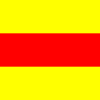
General chase
Encyclopedia



Royal Navy
The Royal Navy is the naval warfare service branch of the British Armed Forces. Founded in the 16th century, it is the oldest service branch and is known as the Senior Service...
’s lexicon of fleet orders; it has a number of connotations beyond its literal meaning and has acquired something of an iconic status.
General Chase is signalled to release ships from a line of battle
Line of battle
In naval warfare, the line of battle is a tactic in which the ships of the fleet form a line end to end. A primitive form had been used by the Portuguese under Vasco Da Gama in 1502 near Malabar against a Muslim fleet.,Maarten Tromp used it in the Action of 18 September 1639 while its first use in...
, or other formation, in order to pursue a retreating or beaten foe.
The signal is appropriate to the end of an action, when victory is certain; it allows all ships to break formation and act independently in order to pursue at best speed to capture or destroy enemy vessels.
In this meaning, it has been used numerous times throughout the Royal Navy's history.
It has, however acquired a more symbolic meaning; used by Nelson at the Battle of the Nile
Battle of the Nile
The Battle of the Nile was a major naval battle fought between British and French fleets at Aboukir Bay on the Mediterranean coast of Egypt from 1–3 August 1798...
at the beginning of the action, when victory was by no means certain, it was an expression of utter confidence, as well as allowing his captains complete discretion.
In this, more iconic meaning, it has been used on two occasions in recent times.
At the Battle of the Falkland Islands
Battle of the Falkland Islands
The Battle of the Falkland Islands was a British naval victory over the Imperial German Navy on 8 December 1914 during the First World War in the South Atlantic...
in 8th December 1914, Sturdee hoisted General Chase at the beginning of the action; and
On 30th July 1943 Captain Fredric Walker
Frederic John Walker
Captain Frederic John Walker, CB, DSO and three Bars, RN was a British Royal Navy officer noted for his exploits during World War II...
signalled "General Chase" when engaging a group of three U-boat
U-boat
U-boat is the anglicized version of the German word U-Boot , itself an abbreviation of Unterseeboot , and refers to military submarines operated by Germany, particularly in World War I and World War II...
s in the Bay of Biscay
Bay of Biscay
The Bay of Biscay is a gulf of the northeast Atlantic Ocean located south of the Celtic Sea. It lies along the western coast of France from Brest south to the Spanish border, and the northern coast of Spain west to Cape Ortegal, and is named in English after the province of Biscay, in the Spanish...
.
The signal is achieved by flying signal flags
International maritime signal flags
The system of international maritime signal flags is one system of flag signals representing individual letters of the alphabet in signals to or from ships...
"2","W", and "N". The flags used by Capt. Walker at his action are preserved in the Bootle
Bootle
Bootle is a town within the Metropolitan Borough of Sefton in Merseyside, England, and a 'Post town' in the L postcode area. Formally known as Bootle-cum-Linacre, the town is 4 miles to the north of Liverpool city centre, and has a total resident population of 77,640.Historically part of...
Town Hall, and there is an exhibit of the same in the Merseyside Maritime Museum
Merseyside Maritime Museum
The Merseyside Maritime Museum is a museum based in the city of Liverpool, Merseyside, England. It is part of National Museums Liverpool and an Anchor Point of ERIH, The European Route of Industrial Heritage...
.

